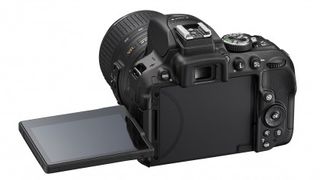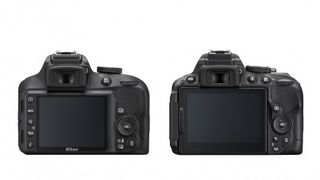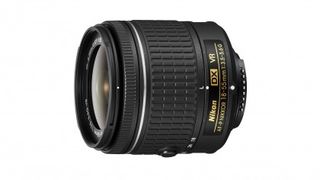
Nikon D3300 vs D5300: Continuous shooting
Why you can trust TechRadar
Any advantage the Nikon D5300 has when it comes to a wider choice of AF points is evened out when it comes to continuous shooting both cameras will let you fire off a burst of five pictures per second in fine-quality JPEG (rather than raw) mode.
Unless you're a sports or wildlife photographer this should be more than enough, and is obviously great for ensuring you get usable shots of fast-moving action.

Nikon D3300 vs D5300: Rear screen
A key difference between the two cameras is the rear screen. The Nikon D5300 boasts a 3.2-inch, 1,037,000-dot screen which can be viewed at different angles.
The screen provides a lovely clear view with lots of detail visible, making it particularly useful for shooting candid street compositions, or in LiveView mode. The screen isn't touch sensitive, though.
In comparison, the Nikon D3300 has a fixed 3-inch screen with 921,000 dots.
Nikon D3300 vs D5300: Connectivity
Again, the Nikon D5300 aces its sibling here. Wi-Fi and GPS connectivity comes as standard on the more expensive camera, while you will have to buy an adaptor for it to work on the D3300.
It's easy to connect the Nikon D5300's Wi-Fi system to your Apple or Android smartphone, but you'll need to download the Nikon Wireless Mobile Utility app to control the camera.
For the Nikon D3300, you need to buy the WU-1a adaptor, which costs around £50/$60.

Nikon D3300 vs D5300: Build quality and dimensions
Both cameras are tough. Their shell is made from one piece of Sereebo CFTRP, a type of polycarbonate. This 'monocoque' construction omits the usual joints and seals, making the camera stronger.
The Nikon D5300 is slightly heavier, weighing in at 530g with battery and memory card, compared to the Nikon D3300's 460g. You'll hardly notice an extra 70g in practice though and both cameras have similar dimensions.
Nikon D3300 vs D5300: Battery life
Guess what, both cameras share the same battery, too. The EN-EL14a can power 700 shots on a single charge.

Nikon D3300 vs D5300: Kit lens
Both cameras now come bundled with the latest retracting AF-P 18-55mm f/3.5-5.6G VR kit lens, making it suitable for both still and video capture thanks to the new Stepping Motor.
Its also much shorter when retracted than its predecessor, getting around the complaint that previous entry-level Nikon DSLRs have felt quite bulky and awkward.
Some kits are available with the older non-VR lens, so pay attention to the spec of the lens to make sure you get the kit you want.
Nikon D3300 vs D5300: Verdict
Given the large number of similarities between the two cameras, it really boils down to how much you value built-in Wi-Fi, a flip-out screen and a few more AF points.
The 'guts' of both cameras are not massively different, both are made from sturdy monocoque casing and both have an easy to understand graphic interface to help beginners figure out camera functions.

If money is tight we recommend going for the Nikon D3300, and if extra money becomes available, put it towards an extra lens (a standard prime like the AF-S 35mm f/1.8G is a great option) or a tripod and some filters.
A good lens and sturdy tripod will have more impact on the quality of your pictures than some extra AF points and built-in Wi-Fi. As for the screen, vari-angle LCDs are nice to have, but photographers have lived without them for a long time...
Get daily insight, inspiration and deals in your inbox
Get the hottest deals available in your inbox plus news, reviews, opinion, analysis and more from the TechRadar team.
The TechRadar hive mind. The Megazord. The Voltron. When our powers combine, we become 'TECHRADAR STAFF'. You'll usually see this author name when the entire team has collaborated on a project or an article, whether that's a run-down ranking of our favorite Marvel films, or a round-up of all the coolest things we've collectively seen at annual tech shows like CES and MWC. We are one.
